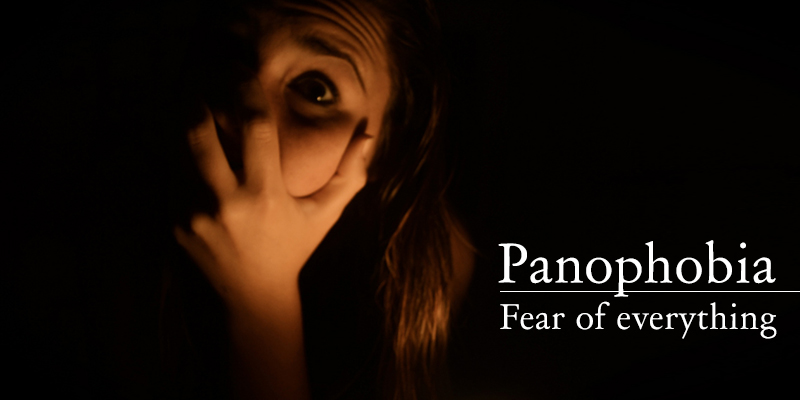We live in this world, between numerous objects, animals and persons, and go through various situations in a single day. We survive by fighting and facing through all of the challenges that life throws at us every day. However, some people fear everything of these. This is one of the most strangest, yet vague kind of fear one could get and is known as panophobia.

The word probably has been derived from “Pan” who is The Greek God known to cause panic, fear and anxiety or another Greek word “Panto” meaning everything. Panophobia, also known as omniphobia, is signified by persistent and intense fear of everything surrounding the person which includes all objects, people, situations and animals. The panophobic person is always worried and fearful that something horrifying would happen. Many other specific phobias can occur with someone having panophobia. This phobia is also closely related with different types of anxiety disorders. As much as this fear seems ambiguous, it can deeply disrupt the life and career of a person.
What Causes Panophobia?
Panophobia is a vicious cycle of other phobias. The person develops panophobia as an outcome of other fear and anxiety, and the fear in turn aggravates the anxiety. The causes responsible for panophobia are:
Specific Phobias
A person doesn’t starts fearing everything at a sudden. Panophobia is always backed by another specific kind of fear. People are more vulnerable if they’ve already got other specific phobias which might be fear of public places (agoraphobia), fear of social situations (social phobia), fear of germs (germophobia), fear of snakes (ophidiophobia), fear of confined spaces (claustrophobia) or many other such fears. A single fear can be responsible to weaken the mind of a person, and he/she starts to inhabit this fear over the extreme. Eventually, the elated amount of fear makes the person distressful and anxious of almost everything around him/her.
Post-Traumatic Depression
Panophobia is also more likely to occur to people who had or have gone through a traumatic event. Trauma is a wound of the mind, and needs plenty of time to heal. Such trauma can cause depression and anxiety in the person. A weakened mind is a home to several other distressful mental conditions. During this time, a person can develop anxiety for everything encircling his/her life.
Genetics
Heredity can also be a contributing factor in panophobia. Studies show that the feelings of fear and anxiety can pass on through genes. These are like personality traits one gets from the family and blood. Gradually, one can develop this kind of phobia.
Symptoms of Panophobia
Major symptoms that can occur with anyone having panophobia are:
- Persistent and extreme fear of everything including objects, animals, insects, people and situations surrounding a person
- Screaming, crying and goose bumps upon the onset of fear
- Isolation and staying away from a regular life
- Increased alertness
- Realizing that the fear is unreasonable ( except in children)
- Low self- image and confidence
- Feeling depressed
- Panic attacks and anxiety with signs such as shaking, sweating, profuse breathing, chest pain, feeling like losing control, heart palpitations, nausea or vomiting, dizziness or fainting and abdominal uneasiness
When to Visit a Doctor?
Panophobia may be rooted from another specific phobia which had been unnoticed. The fear can be confusing and unexplainable, and make the person even more vulnerable to feel anxious. On the other hand, it is like a vicious cycle of depression, phobias and anxiety. If left untreated, the person can develop other depressive disorders and completely disrupt one’s life. If the above symptoms have been damaging to that extent and prolonged for more than six months, one needs to consult a doctor and start with the treatment process.
How is Panophobia Treated?
Panophobia can be treated using a combination of psychotherapies and medicines. These are:
Exposure Therapy with Relaxation
Exposure therapy is one of the effective psychotherapies in treating panophobia. The therapist guides the person through regular exposures with the objects, people or situations that develop the anxiety. This is a slow process, and the therapist starts from mild settings to trigger the fear. The therapist also teaches various relaxation ways such as controlled breathing, muscle relaxation, meditation and mind visualization. The person needs to use these relaxation methods during the exposure sessions, and bring the fear under control.
Cognitive Behavioral Therapy (CBT)
CBT is aimed at understanding and recognizing the negative images creating the fear. A panophobic person generally perceives everything to be made of something evil, and anticipates something terrifying to happen anytime. CBT is a therapy which tries to eliminate these kinds of upsetting thoughts and build a positive life. It uses extensive counseling sessions for the person to talk and share about his/her fear, thoughts and weaknesses.
Medicines
In severe cases of panicking and anxiety, medications may be used to control the symptoms. Commonly used medicines are anti-anxiety and anti-depressant drugs. These medicines help to adjust the serotonin levels which is responsible for determining the temperament of a person